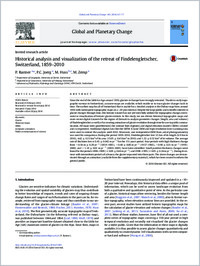Historical analysis and visualization of the retreat of Findelengletscher, Switzerland, 1859–2010
- Rastner, P. Department of Geography, University of Zurich, Switzerland
- Joerg, P.C. Department of Geography, University of Zurich, Switzerland
- Huss, Matthias Department of Geosciences, University of Fribourg, Switzerland - Laboratory of Hydraulics, Hydrology and Glaciology (VAW), ETH Zurich, Switzerland
- Zemp, Michael Department of Geography, University of Zurich, Switzerland
-
01.10.2016
Published in:
- Global and Planetary Change. - 2016, vol. 145, p. 67–77
English
Since the end of the Little Ice Age around 1850, glaciers in Europe have strongly retreated. Thanks to early topographic surveys in Switzerland, accurate maps are available, which enable us to trace glacier changes back in time. The earliest map for all of Switzerland that is usable for a detailed analysis is the Dufour map from around 1850 with subsequent topographic maps on a ~ 20 year interval. Despite the large public and scientific interest in glacier changes through time, this historic dataset has not yet been fully utilized for topographic change assessment or visualization of historic glacier extents. In this study, we use eleven historical topographic maps and more recent digital datasets for the region of Zermatt to analyze geometric changes (length, area and volume) of Findelengletscher as well as for creating animations of glacier evolution through time for use in public communication. All maps were georeferenced, the contour lines digitized, and digital elevation models (DEMs) created and co-registered. Additional digital data like the SRTM X-band DEM and high resolution laser scanning data were used to extend the analysis until 2010. Moreover, one independent DEM from aerial photogrammetry was used for comparison. During the period 1859–2010, Findelengletscher lost 3.5 km of its length (6.9 km in 2010), 4.42 ± 0.13 km² of its area (15.05 ± 0.45 km² in 2010) and 1.32 ± 0.52 km³ of its volume. The average rate of thickness loss is 0.45 ± 0.042 m yr− 1 for the 151 years period. Four periods with high thickness change from − 0.56 m ± 0.28 yr− 1 (1859–1881), − 0.40 ± 0.08 m yr− 1 (1937–1965), − 0.90 ± 0.31 m yr− 1 (1995–2000) and − 1.18 ± 0.02 m yr− 1 (2000–2005) have been identified. Small positive thickness changes were found for the periods 1890–1909 (+ 0.09 ± 0.46 m yr − 1) and 1988–1995 (+ 0.05 ± 0.24 m yr− 1). During its retreat with intermittent periods of advance, the glacier separated into three parts. The above changes are demonstrated through an animation (available from the supplementary material), which has been created to inform the general public.
- Faculty
- Faculté des sciences et de médecine
- Department
- Département de Géosciences
- Language
-
- English
- Classification
- Hydrology
- License
- License undefined
- Identifiers
-
- RERO DOC 278556
- DOI 10.1016/j.gloplacha.2016.07.005
- Persistent URL
- https://folia.unifr.ch/unifr/documents/305389
Statistics
Document views: 44
File downloads:
- hus_hav.pdf: 223
